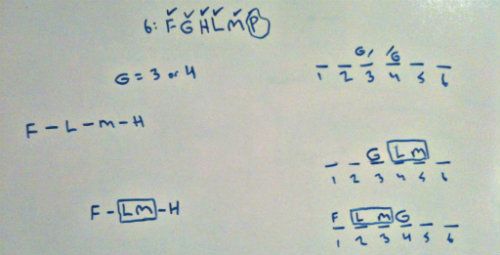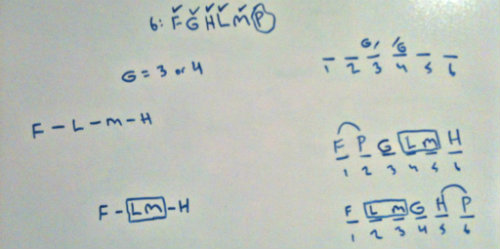LSAT Forum
3 postsPage 1 of 1
-

- timmydoeslsat
-
Thanks Received: 887
-
Atticus Finch

- Posts: 1136
- Joined: June 20th, 2011
- This post thanked 1 time.

- Most Thanked

- First Responder
Re: Q3
My global diagram:

Question 3, as you can see, is a local question that tells us that M is third. We now know that G must be fourth since we were told that G was either 3 or 4.
We are asked for the soonest placement of P. With M being third, we can see on our global diagram that two variables must precede M, and in this order: F - L

We have only two variables left to place: P and H. The only rule governing the use of H is that it is to follow M, which it will do in either slot 5 or 6. So in regards to this question, we can place P 5th, which is the soonest we could do so with M third. Answer choice (D).
Question 5 is a global question asking us for a variable that could be placed in any slot. We know for sure that our floater, P, is one of those. Our answer is (E).
Question 6 is a local question that supplies us with a block of LM and asks us what could be true.
In this situation, I would frame what happens with G third and what happens with G fourth.

In the G3 example, the only place I can put LM is 4-5 so I can leave room for H.
In the G4 example, the only place I can put LM is 2-3 so I can leave room for F.

In the G3 example, only two variables are left: F and P. They can trade off in slots 1 and 2.
In the G4 example, only two variables are left: H and P. They can trade off in slots 5 and 6.
(A) is the only one that can be true. H could be 5th in the G4 example.

Question 3, as you can see, is a local question that tells us that M is third. We now know that G must be fourth since we were told that G was either 3 or 4.
We are asked for the soonest placement of P. With M being third, we can see on our global diagram that two variables must precede M, and in this order: F - L

We have only two variables left to place: P and H. The only rule governing the use of H is that it is to follow M, which it will do in either slot 5 or 6. So in regards to this question, we can place P 5th, which is the soonest we could do so with M third. Answer choice (D).
Question 5 is a global question asking us for a variable that could be placed in any slot. We know for sure that our floater, P, is one of those. Our answer is (E).
Question 6 is a local question that supplies us with a block of LM and asks us what could be true.
In this situation, I would frame what happens with G third and what happens with G fourth.

In the G3 example, the only place I can put LM is 4-5 so I can leave room for H.
In the G4 example, the only place I can put LM is 2-3 so I can leave room for F.

In the G3 example, only two variables are left: F and P. They can trade off in slots 1 and 2.
In the G4 example, only two variables are left: H and P. They can trade off in slots 5 and 6.
(A) is the only one that can be true. H could be 5th in the G4 example.
3 posts Page 1 of 1
